What is SmartFit?
SmartFit Is an AI-powered mobile application designed to serve as a virtual fitting room, helping users seamlessly choose, try on, and mix outfits from both their existing wardrobe and a shopping catalog. Using advanced virtual try-on technology.
SmartFit Is an AI-powered mobile application designed to serve as a virtual fitting room, helping users seamlessly choose, try on, and mix outfits from both their existing wardrobe and a shopping catalog. Using advanced virtual try-on technology.
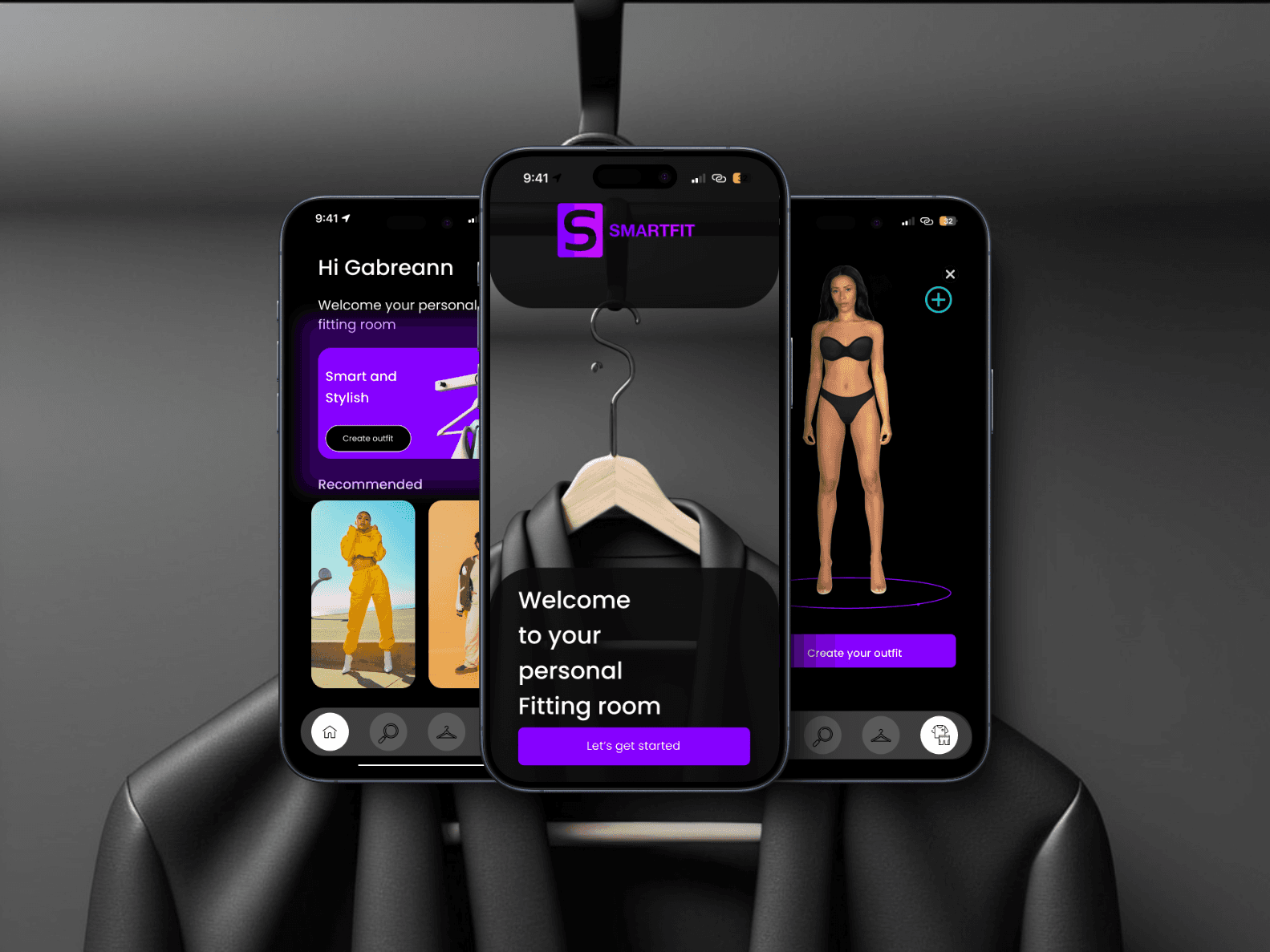


I was the sole designer on this project, working closely with the project manager, owner, and development team.
I was the sole designer on this project, working closely with the project manager, owner, and development team.
User researcher
Behaviour analysis
Prototype
Prototype
User testing
Duration
2 months
Team
Project manager
Project manager
Founder
Founder
AI engineer
AI engineer
Developer
Developer
Tools
Figma
Miro
Trello
UserTesting
Slack
Google platforms



Research phase
Research phase
Research phase
To kick off the project, I explored different research methods, with the first step being to understand the idea and motivation behind the project.
To kick off the project, I explored different research methods, with the first step being to understand the idea and motivation behind the project.
To kick off the project, I explored different research methods, with the first step being to understand the idea and motivation behind the project.
Stakeholders Research
To fully understand the scope of the project, I had a one-to-one session with the stakeholders. during the session, I was able to understand the motivation behind the project and business goals.
To fully understand the scope of the project, I had a one-to-one session with the stakeholders. during the session, I was able to understand the motivation behind the project and business goals.
Findings from the meeting
The issue of my client's wife spending excessive time searching for the perfect outfit, which often caused them to be late to events, led the client to want to create a solution. This recurring problem inspired the development of an app aimed at improving shopping and wardrobe management.
The issue of my client's wife spending excessive time searching for the perfect outfit, which often caused them to be late to events, led the client to want to create a solution. This recurring problem inspired the development of an app aimed at improving shopping and wardrobe management.
Project Goals
To Reduce Time in Outfit Selection.
Enhance Fit Accuracy and Personalization. •
Seamlessly Integrate Wardrobe and Shopping Catalogs.
Decrease Return Rates and Increase User Satisfaction.
To Reduce Time in Outfit Selection.
Enhance Fit Accuracy and Personalization. •
Seamlessly Integrate Wardrobe and Shopping Catalogs.
Decrease Return Rates and Increase User Satisfaction.
Preliminary Hypothesis
trying on clothes is a major pain point for shoppers, caused by long fitting room waits, inconsistent sizing across brands, and the difficulty in visualizing how items will fit and look without physical trials.
trying on clothes is a major pain point for shoppers, caused by long fitting room waits, inconsistent sizing across brands, and the difficulty in visualizing how items will fit and look without physical trials.
User Research
In order to gain a comprehensive understanding of user awareness and behavior regarding virtual fitting rooms, I decided to take a deeper, more nuanced approach. I employed a mixed-method research strategy, combining both quantitative data from surveys and user analytics with qualitative insights gathered from interviews and focus groups. This approach allowed me to capture a well-rounded perspective, ensuring that I could not only measure how users interacted with the virtual fitting room but also understand their emotions, challenges, and expectations. By blending these methods, I was able to uncover a rich set of insights that painted a clear picture of the current user experience and helped inform the design of a more intuitive, user-centered solution.
In order to gain a comprehensive understanding of user awareness and behavior regarding virtual fitting rooms, I decided to take a deeper, more nuanced approach. I employed a mixed-method research strategy, combining both quantitative data from surveys and user analytics with qualitative insights gathered from interviews and focus groups. This approach allowed me to capture a well-rounded perspective, ensuring that I could not only measure how users interacted with the virtual fitting room but also understand their emotions, challenges, and expectations. By blending these methods, I was able to uncover a rich set of insights that painted a clear picture of the current user experience and helped inform the design of a more intuitive, user-centered solution.
Quantitative
A survey was distributed to 100 individuals via social media platforms, including Facebook, WhatsApp, Instagram, and Telegram. A total of 38 responses were received, providing valuable quantitative insights into general trends and patterns.
A survey was distributed to 100 individuals via social media platforms, including Facebook, WhatsApp, Instagram, and Telegram. A total of 38 responses were received, providing valuable quantitative insights into general trends and patterns.
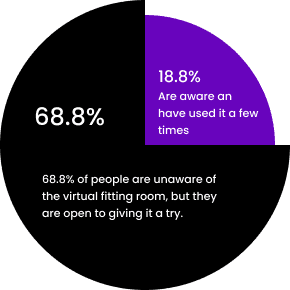

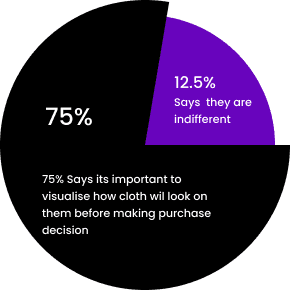

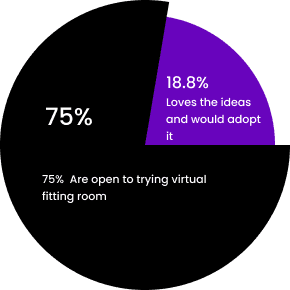

Key Findings
The data revealed that 68.3% of users were unfamiliar with the concept, while 75% stated that visualizing how clothes would look on them would significantly influence their purchasing decisions.
The data revealed that 68.3% of users were unfamiliar with the concept, while 75% stated that visualizing how clothes would look on them would significantly influence their purchasing decisions.
User Research
To complement the survey data, I conducted in-depth interviews with 5 participants, recruited through platforms such as Instagram and LinkedIn, to gather nuanced, qualitative insights into user experiences and perceptions.
To complement the survey data, I conducted in-depth interviews with 5 participants, recruited through platforms such as Instagram and LinkedIn, to gather nuanced, qualitative insights into user experiences and perceptions.
Quantitative
A survey was distributed to 100 individuals via social media platforms, including Facebook, WhatsApp, Instagram, and Telegram. A total of 38 responses were received, providing valuable quantitative insights into general trends and patterns.
A survey was distributed to 100 individuals via social media platforms, including Facebook, WhatsApp, Instagram, and Telegram. A total of 38 responses were received, providing valuable quantitative insights into general trends and patterns.
Time Contraints


Time-consuming to find the right size and outfit (2-5 hours shopping)Time-consuming to find the right size and outfit (2-5 hours shopping)


Time-consuming to find the right size and outfit (2-5 hours shopping)Time-consuming to find the right size and outfit (2-5 hours shopping)


Exhaustion from trying on clothes and frustration with store travel and sizing inconsistencies


Dislikes store shopping and trying on clothes due to time constraints
Motivations


Enjoys looking smart and decent when stepping out


Wants confidence in outfit choices


Seeks to balance time and still look good


Values efficiency and convenience
Behaviours


Enjoys looking smart and decent when stepping out


Wants confidence in outfit choices


Seeks to balance time and still look good


Values efficiency and convenience
Motivations


Enjoys looking smart and decent when stepping out


Wants confidence in outfit choices


Seeks to balance time and still look good


Values efficiency and convenience
Key Findings
Insights from user reviews revealed that customers often spend a significant amount of time trying to find the perfect outfit. The time spent in stores trying on clothes could be better utilized for more productive activities.
Insights from user reviews revealed that customers often spend a significant amount of time trying to find the perfect outfit. The time spent in stores trying on clothes could be better utilized for more productive activities.
Define phase
User Story
A streamlined solution is needed to simplify the process of selecting and trying on outfits from both existing wardrobes and online stores. Combining virtual fitting with wardrobe management can reduce the time spent on physical trials and address issues with inconsistent sizing, making the shopping experience more efficient and enjoyable.
A streamlined solution is needed to simplify the process of selecting and trying on outfits from both existing wardrobes and online stores. Combining virtual fitting with wardrobe management can reduce the time spent on physical trials and address issues with inconsistent sizing, making the shopping experience more efficient and enjoyable.
Problem statement
Users need a more convenient and efficient experience that allows them to confidently select outfits that fit well and match their style, while eliminating the need for time-consuming physical trials.
Users need a more convenient and efficient experience that allows them to confidently select outfits that fit well and match their style, while eliminating the need for time-consuming physical trials.
How might we statement
How might we provide a seamless experience for users to select, try on, and mix and match outfits from their wardrobe and shopping catalog, ensuring accurate fit and style, while saving time and enhancing the overall user experience
How might we provide a seamless experience for users to select, try on, and mix and match outfits from their wardrobe and shopping catalog, ensuring accurate fit and style, while saving time and enhancing the overall user experience
User persona
A streamlined solution is needed to simplify the process of selecting and trying on outfits from both existing wardrobes and online stores. Combining virtual fitting with wardrobe management can reduce the time spent on physical trials and address issues with inconsistent sizing, making the shopping experience more efficient and enjoyable.
A streamlined solution is needed to simplify the process of selecting and trying on outfits from both existing wardrobes and online stores. Combining virtual fitting with wardrobe management can reduce the time spent on physical trials and address issues with inconsistent sizing, making the shopping experience more efficient and enjoyable.
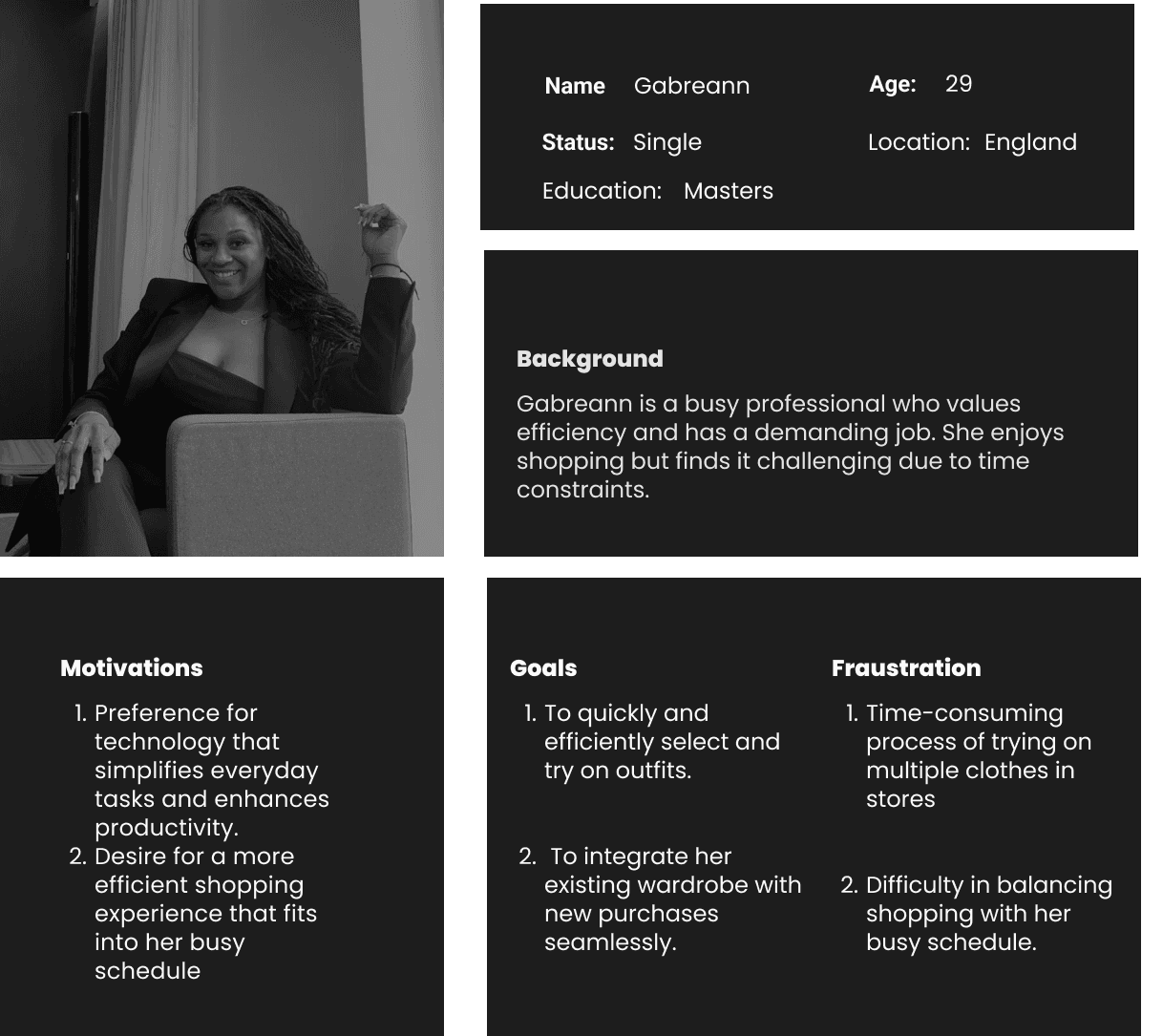





With the user research wrapped up, we now have a clear understanding of user needs, challenges, and expectations. These insights provide a strong foundation for the next step: crafting user flows that seamlessly guide users toward their goals while addressing their pain points.
With the user research wrapped up, we now have a clear understanding of user needs, challenges, and expectations. These insights provide a strong foundation for the next step: crafting user flows that seamlessly guide users toward their goals while addressing their pain points.
Ideation phase
The ideation phase focused on exploring creative solutions to enhance user engagement and streamline outfit selection. By identifying user needs and pain points, we generated and refined concepts that would form the foundation of the app’s key features—mixing and matching outfits from both personal wardrobes and the online store.
The ideation phase focused on exploring creative solutions to enhance user engagement and streamline outfit selection. By identifying user needs and pain points, we generated and refined concepts that would form the foundation of the app’s key features—mixing and matching outfits from both personal wardrobes and the online store.



Task flow one
The first flow outlines the steps the user takes to mix and match outfits from their wardrobe, guiding them from the dashboard to the virtual fitting room. The task has been designed to make the experience easy and intuitive.
The first flow outlines the steps the user takes to mix and match outfits from their wardrobe, guiding them from the dashboard to the virtual fitting room. The task has been designed to make the experience easy and intuitive.



Task flow two
This outlines the steps the user takes to mix-match outfit from their online store which takes them from the dashboard to virtual fitting room. the task has been designed to make the experience easy and intuitive
This outlines the steps the user takes to mix-match outfit from their online store which takes them from the dashboard to virtual fitting room. the task has been designed to make the experience easy and intuitive
Information architecture
By logically grouping and labelling sections, I created a user friendly layout that supports intuitive navigation. This architecture is designed to simplify the user experience, making it easy for users to move between tasks, whether they’re trying on clothes, saving outfits, or checking measurements without confusion or unnecessary steps.
By logically grouping and labelling sections, I created a user friendly layout that supports intuitive navigation. This architecture is designed to simplify the user experience, making it easy for users to move between tasks, whether they’re trying on clothes, saving outfits, or checking measurements without confusion or unnecessary steps.
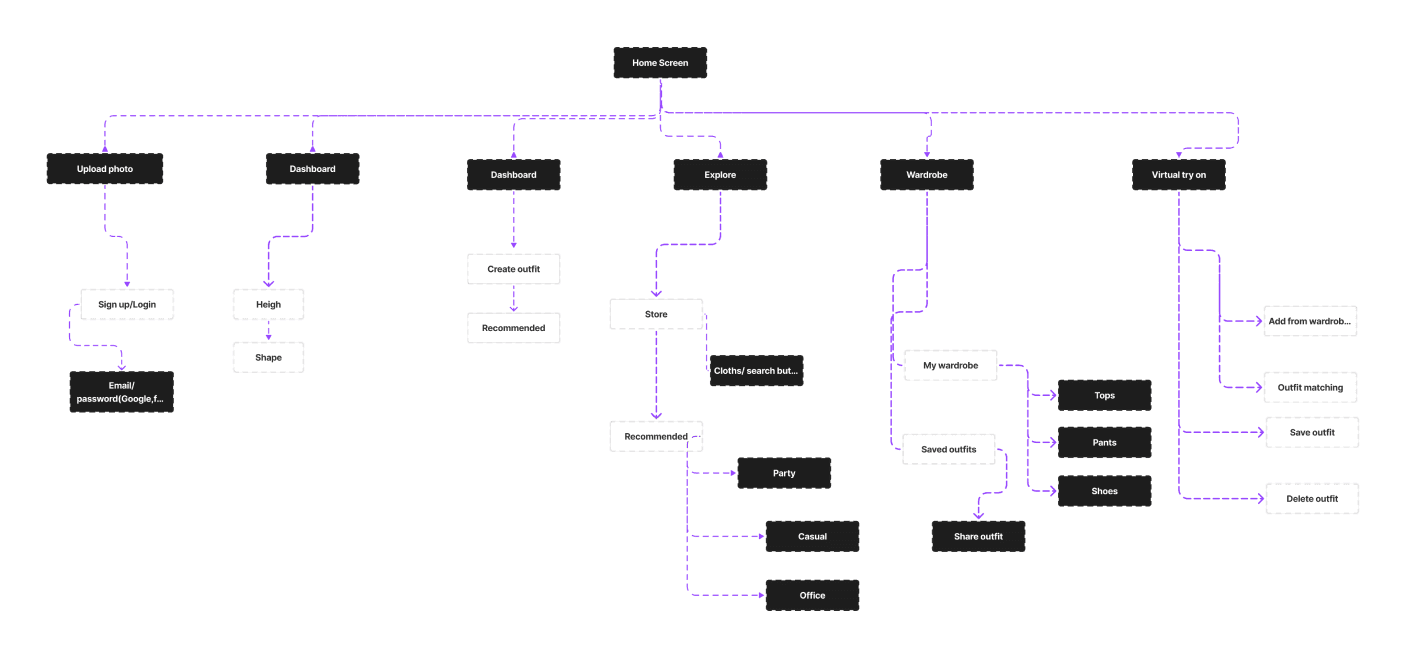


Wireframes
The sketch illustrates the onboarding process, starting with registering your personal details like email address and password. Following this, you proceed to the body measurement section, where you manually input measurements for various body parts, including height, chest, hips, and others.
The sketch illustrates the onboarding process, starting with registering your personal details like email address and password. Following this, you proceed to the body measurement section, where you manually input measurements for various body parts, including height, chest, hips, and others.






Prototyping phase
The prototypes were specifically designed to help test the ability of testing cloths from your wardrobe and online store through inputing your body sizes and selecting your prefered avatar
The prototypes were specifically designed to help test the ability of testing cloths from your wardrobe and online store through inputing your body sizes and selecting your prefered avatar
The prototypes were specifically designed to help test the ability of testing cloths from your wardrobe and online store through inputing your body sizes and selecting your prefered avatar






Usability testing
The usability testing began with an initial group of five participants, who also took part in preliminary interviews to share insights on their experiences and expectations. These participants were assigned two main tasks to assess the functionality and user-friendliness of the platform. The first task involved creating an outfit using items from their virtual wardrobe, allowing testers to explore how seamlessly they could navigate their existing digital clothing collection to put together an outfit. The second task required them to create an outfit using items from an online store, evaluating the ease of browsing, selecting, and adding new items to their wardrobe from an external source. These tasks were designed to provide insights into user interaction patterns, potential challenges, and overall satisfaction with the system’s core features.#
The usability testing began with an initial group of five participants, who also took part in preliminary interviews to share insights on their experiences and expectations. These participants were assigned two main tasks to assess the functionality and user-friendliness of the platform. The first task involved creating an outfit using items from their virtual wardrobe, allowing testers to explore how seamlessly they could navigate their existing digital clothing collection to put together an outfit. The second task required them to create an outfit using items from an online store, evaluating the ease of browsing, selecting, and adding new items to their wardrobe from an external source. These tasks were designed to provide insights into user interaction patterns, potential challenges, and overall satisfaction with the system’s core features.#



The body and size measurement process took about five minutes to complete, allowing users to carefully input a series of specific measurements, entering measurements for various body parts, including height, chest, waist, hips, and potentially additional areas depending on the level of detail required. This process was crafted to be thorough yet manageable within a brief period, ensuring that users could provide accurate data without feeling overwhelmed.
The body and size measurement process took about five minutes to complete, allowing users to carefully input a series of specific measurements, entering measurements for various body parts, including height, chest, waist, hips, and potentially additional areas depending on the level of detail required. This process was crafted to be thorough yet manageable within a brief period, ensuring that users could provide accurate data without feeling overwhelmed.
The body and size measurement process took about five minutes to complete, allowing users to carefully input a series of specific measurements, entering measurements for various body parts, including height, chest, waist, hips, and potentially additional areas depending on the level of detail required. This process was crafted to be thorough yet manageable within a brief period, ensuring that users could provide accurate data without feeling overwhelmed.



Various avatar body types were offered based on user preferences to better match their appearance and create a more personal connection.
Various avatar body types were offered based on user preferences to better match their appearance and create a more personal connection.
Various avatar body types were offered based on user preferences to better match their appearance and create a more personal connection.



This section allowed users to mix and match clothing items from their virtual wardrobe and online stores, using their selected avatar for a personalized styling experience.
This section allowed users to mix and match clothing items from their virtual wardrobe and online stores, using their selected avatar for a personalized styling experience.
This section allowed users to mix and match clothing items from their virtual wardrobe and online stores, using their selected avatar for a personalized styling experience.


Gabreann
The registration and body measurement process was too time consuming and cumbersome.


Babara
Participants expressed a strong preference for using their own photos over avatars, which they found less realistic and personal.


Lauren
Users didn't trust the avatar based fitting system and felt it didn't reflect their real body shape accurately.
Key Findings
Main Pain Point: The registration and body measurement process was too time consuming and cumbersome.
User Preferences: Participants expressed a strong preference for using their own photos over avatars, which they found less realistic and personal.
Trust and Accuracy: Users didn’t fully trust the avatar-based fitting system and felt it didn’t reflect their real body shape accurately.
Main Pain Point: The registration and body measurement process was too time consuming and cumbersome.
User Preferences: Participants expressed a strong preference for using their own photos over avatars, which they found less realistic and personal.
Trust and Accuracy: Users didn’t fully trust the avatar-based fitting system and felt it didn’t reflect their real body shape accurately.
Iteration phase
After completing the testing phase, we gained valuable insights into previously overlooked areas, which led us to reshape our initial concept. We chose to act on these findings by thoroughly analyzing the collected data and revisiting the empathy and ideation phases to create a new approach. Fresh sketches and wireframes were developed to align with our updated insights. Now, users can upload their photos, allowing artificial intelligence to analyze the image, identify sizing, and assess body type. This enhancement reduces the time users would spend manually entering those details by 5-10 minutes, streamlining the experience significantly.
After completing the testing phase, we gained valuable insights into previously overlooked areas, which led us to reshape our initial concept. We chose to act on these findings by thoroughly analyzing the collected data and revisiting the empathy and ideation phases to create a new approach. Fresh sketches and wireframes were developed to align with our updated insights. Now, users can upload their photos, allowing artificial intelligence to analyze the image, identify sizing, and assess body type. This enhancement reduces the time users would spend manually entering those details by 5-10 minutes, streamlining the experience significantly.
After completing the testing phase, we gained valuable insights into previously overlooked areas, which led us to reshape our initial concept. We chose to act on these findings by thoroughly analyzing the collected data and revisiting the empathy and ideation phases to create a new approach. Fresh sketches and wireframes were developed to align with our updated insights. Now, users can upload their photos, allowing artificial intelligence to analyze the image, identify sizing, and assess body type. This enhancement reduces the time users would spend manually entering those details by 5-10 minutes, streamlining the experience significantly.






Final prototype
The final prototype was thoughtfully developed by integrating key insights obtained from extensive user research and usability testing. These insights guided adjustments in functionality, layout, and interaction flow, resulting in a design closely aligned with user needs and expectations.
The final prototype was thoughtfully developed by integrating key insights obtained from extensive user research and usability testing. These insights guided adjustments in functionality, layout, and interaction flow, resulting in a design closely aligned with user needs and expectations.
The final prototype was thoughtfully developed by integrating key insights obtained from extensive user research and usability testing. These insights guided adjustments in functionality, layout, and interaction flow, resulting in a design closely aligned with user needs and expectations.











